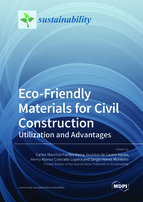Eco-Friendly Materials for Civil Construction: Utilization and Advantages
A special issue of Sustainability (ISSN 2071-1050). This special issue belongs to the section "Sustainable Materials".
Deadline for manuscript submissions: closed (1 August 2022) | Viewed by 29163
Special Issue Editors
Interests: foundry; bricks; porosity; ceramics; microstructure and solid waste
Special Issues, Collections and Topics in MDPI journals
Interests: red ceramics; mortars; industrial wastes; natural fibers; Durability
Interests: solid waste management; hazardous waste; ceramics; circular economy; natural fibers
Interests: less common latural fibers; thermorigid composites; mechanicla properties; fabric reinforced composites; fracture mechanics
Special Issues, Collections and Topics in MDPI journals
Special Issue Information
Dear Colleagues,
Planet Earth is becoming unsustainable for a society with a lifestyle that is increasingly consumerist and predatory to the environment. The linear economy has failed as a viable form of human development, as it entails a huge generation of waste and a negative impact on the environment. We currently consume poorly designed and energy-inefficient products that do not have adequate reuse, and therefore, the development of sustainable materials is mandatory as one of the pillars for the transition from a linear to a circular economy.
This Special Edition is dedicated to papers from academic researchers and industry innovators working on multidisciplinary experiments as well as modeling related to environmental sustainability. Papers are also welcome on economic and social aspects that would promote changes in the behavior that lead to disseminating the sustainable development of building constructions to preserve the environment. In particular, papers on construction materials used worldwide are encouraged aiming at improving efficiency, productivity, and competitiveness in world markets.
For this Special Issue, both scientific and technical papers are welcome aiming at our advanced understanding of ecofriendly building materials, which might promote savings in energy as well as pollutant reduction in the extraction of raw materials, manufacturing processes, or in final applications. These building materials can be more durable and also incorporated with urban, agricultural, or industrial wastes.
The main topics covered in this Special Issue include (but are not limited to):
- Characterization, processing, and technological properties of ecofriendly building materials;
- Analysis of the lifecycle of building materials;
- Waste-incorporated building materials;
- Recycling and circular economy of building materials;
- Heavy ceramics with industrial and agro-industrial residues;
- Mortar with industrial wastes;
- Mortar with natural fibers;
- Alkali-activated materials with industrial wastes;
- Composite with natural fibers and wastes;
- Artificial rocks with industrial waste;
- Cleaner steel manufacturing process.
Original studies and reviews on subjects other than the aforementioned that are deemed to contribute to an advance in the knowledge of ecofriendly building materials, their utilization, and advantages are welcome in this Special Issue.
AREA
Area of materials and technology: clay, heavy clay ceramics, mortars, alkali-activated materials, composites, natural and synthetic fibers, structural reinforcement, recycled materials, byproducts, and steel.
Prof. Dr. Carlos Maurício Fontes Vieira
Prof. Dr. Gustavo de Castro Xavier
Prof. Dr. Henry Alonso Colorado Lopera
Prof. Dr. Sergio Neves Monteiro
Guest Editors
Manuscript Submission Information
Manuscripts should be submitted online at www.mdpi.com by registering and logging in to this website. Once you are registered, click here to go to the submission form. Manuscripts can be submitted until the deadline. All submissions that pass pre-check are peer-reviewed. Accepted papers will be published continuously in the journal (as soon as accepted) and will be listed together on the special issue website. Research articles, review articles as well as short communications are invited. For planned papers, a title and short abstract (about 100 words) can be sent to the Editorial Office for announcement on this website.
Submitted manuscripts should not have been published previously, nor be under consideration for publication elsewhere (except conference proceedings papers). All manuscripts are thoroughly refereed through a single-blind peer-review process. A guide for authors and other relevant information for submission of manuscripts is available on the Instructions for Authors page. Sustainability is an international peer-reviewed open access semimonthly journal published by MDPI.
Please visit the Instructions for Authors page before submitting a manuscript. The Article Processing Charge (APC) for publication in this open access journal is 2400 CHF (Swiss Francs). Submitted papers should be well formatted and use good English. Authors may use MDPI's English editing service prior to publication or during author revisions.
Keywords
- ecofriendly ceramics
- life cycle analysis
- agro-industrial and urban waste added building materials
- circular economy
- energy efficiency
- recycling
- mining and sustainability






